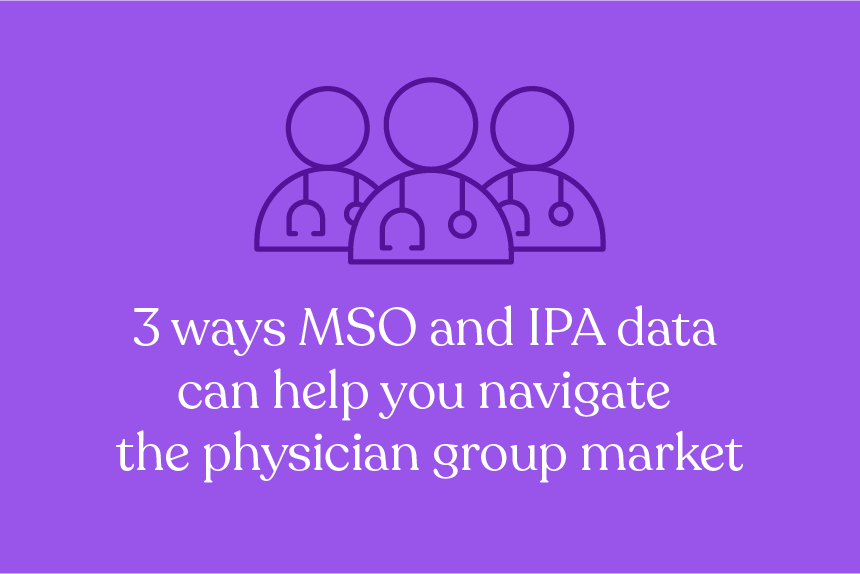3 ways MSO and IPA data can help you navigate the physician group market
Aug 8th, 2024

Physician groups wield considerable power within the healthcare market. They often serve as the first point of contact for many patients and help coordinate care with specialists, hospitals, and other facilities. As a result, physician groups are quite influential in patient referrals, treatment decisions, the adoption of new technologies, and more.
For companies aiming to sell to physician groups, it's critically important to understand the organizational structures that support them. Two entities that have emerged from healthcare’s alphabet soup are management service organizations (MSOs) and independent physician associations (IPAs).
What’s the difference between management service organizations (MSOs) and independent physician associations (IPAs)?
MSOs and IPAs serve physician group groups in important but distinct ways. MSOs act as the operational backbone for physician groups, handling administrative tasks and allowing physicians to focus on patient care. IPAs, on the other hand, unite independent physicians to negotiate contracts with payors and enhance their collective bargaining power.
By understanding the role of MSOs and IPAs, companies can gain a competitive edge in targeting physician groups. Taking a data-driven approach can help you precisely segment the market, make more informed decisions, and increase productivity.
Leveraging MSO and IPA data for precise market segmentation
Identifying distinct segments within your customer base can help you address unmet needs, customize your offerings, and find new opportunities for growth and innovation.
With MSO and IPA data, you can get a more granular look into the physician group landscape, resulting in highly targeted segments. While there are countless ways to define your market segments, four of the most useful categories are:
Physician specialty
It goes without saying, but different specialties have different clinical and operational challenges. If your product or service is used to help diagnose or treat cardiological diseases, you should target physician practices with cardiologists or cardiac imaging specialists. If you have an orthopedic device, your best targets are probably orthopedic surgeons. Focus on the specialties relevant to your solution.
When dealing with physician groups, however, it’s important to recognize how MSOs and IPAs impact a physician group's specialty composition. An MSO may recruit specific specialists to fill service gaps in their network. For example, an MSO managing a physician group that serves a large population of elderly patients could reasonably prioritize cardiologists, orthopedists, and geriatricians. IPAs might focus on meeting the needs of the community within a geographic area or the needs of their payors, which can be different across rural and urban areas.
Diagnosis and procedure volumes
Both diagnosis and procedure volumes are important metrics as they can represent a prospect’s opportunity value, which is useful for targeting and prioritization purposes.
Practices performing a high volume of specific procedures may be early adopters of new technologies or have a greater need for efficiency-enhancing solutions. Groups managing patients with complex conditions often require specialized tools and support services. Carefully analyzing diagnosis and procedure volume data can help you make more granular segments within the physician group market and tailor your solutions accordingly.
Referral volume
Understanding why patients are referred (and who they’re being referred to) can highlight areas of strength or weakness within a physician practice. It can be a great way to identify opportunities where your product or service could intervene in the patient journey or improve physician performance. Like diagnosis and procedure volumes, referral trends offer valuable insights into how your solutions can specifically address the challenges or problems your customers face.
MSOs have an influential role in how referral networks are managed within their physician groups. They may negotiate contracts with preferred providers, implement referral management systems, or provide incentives for in-network referrals.
Affiliations
The facilities and institutions a physician group may be affiliated with reveal insights into how they operate within the healthcare landscape. An affiliation with a hospital influences the physician group’s bargaining power with payors and other providers and impacts access to resources or how patients are referred.
At the same time, an affiliation with an academic medical center, for example, could suggest a higher proportion of complex cases or a need for specific technologies, software, and specialists. By analyzing physician group affiliations, you’ll get a better understanding of what makes each practice unique and the opportunity value they represent, which you can use to prioritize the right prospects and develop more targeted marketing and sales strategies.
Making more informed decisions using MSOs and IPAs
Beyond market segmentation, you can use MSO and IPA data to gauge how well a physician group performs so you can make more informed decisions regarding partnerships and acquisitions.
There are several important metrics to consider.
- Financial performance: Revenue growth, insurance claims, Medicare charges and payments, and others can provide a comprehensive picture of an MSO or IPA’s financial health—and that of their physician groups.
- Technology adoption: The technologies an IPA or MSO uses, and their willingness to adopt new solutions, can impact operational efficiency, patient care quality, and overall competitive advantage.
- Claims analytics: Medical claims data can reveal a lot about how a physician group within an MSO or IPA operates. Evaluate claims data to deepen your understanding of your target’s patient population, see how efficient their revenue cycle management is and whether they have high denial rates, and determine areas that could lead to regulatory issues or compliance risks.
While the above definitely isn’t an exhaustive list, you can get an idea of how taking a comprehensive, holistic approach to evaluating MSOs and IPAs can strengthen your decision-making, whether it’s to develop more effective strategies or to assess the suitability of an acquisition target for maximum ROI.
Ultimately, most physicians and groups join IPAs and MSOs to improve and streamline practice management. Without one of these organizations, small practices might feel bogged down by administrative or management-related tasks and have less time to focus on providing clinical care. Leverage the above metrics and other insights you can gather to refine your value proposition and customize your messaging to optimize your chances for a successful engagement.
Increase team productivity
In today’s fiercely competitive landscape, having access to relevant, accurate, and up-to-date healthcare commercial intelligence is crucial to navigating the market and getting a competitive edge. Put simply, having MSO and IPA data easily on hand can significantly streamline your sales and marketing teams’ workflows and boost productivity.
We’ve already mentioned how MSO and IPA data can make it easier to segment the market and make more informed decisions. And with MSO and IPA data now available through our PhysicianGroupView product, you’ll be able to get the intelligence you need and execute a plan faster and more confidently.
Our MSO and IPA datasets combine powerful physician, location, and claims-based data elements to deliver a holistic view of an MSO or IPA’s membership and performance, eliminating time spent searching for and combining data.
Navigate the physician group market with ease
From precise market segmentation and tailored messaging to more informed decision-making and accelerated sales cycles, MSO and IPA data is a powerful tool to help you drive better business performance.
PhysicianGroupView can help you understand the intricate role these entities play in supporting physician groups and enhance your commercialization strategy. And when paired with medical claims data, technology installations, financial metrics, news, and executive contacts, you’ll have an unmatched competitive edge in the physician group market.
Interested in exploring MSOs and IPAs? Start a free trial with Definitive Healthcare today.

